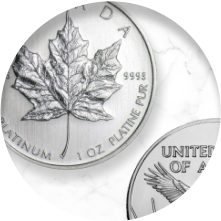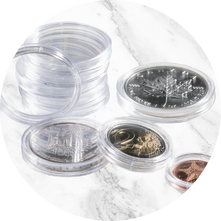Gold, Silver, and a ‘Terrible’ U.S. Jobs Report - Weekly Wrap Up

Did you know you can get the Sprott Money Weekly Wrap Ups, Ask The Expert,
special promotions and insightful blog posts sent right to your inbox?
Sign up to the Sprott Money Newsletter here.
After a strong start to the week, investors rushed to the exits ahead of what was expected to be a strong U.S. jobs report—but the numbers were much worse than anticipated. What does that mean for precious metals? Host Craig Hemke sits down with mining executive and market analyst David Jensen to break down all the gold and silver news you need to see where we go from here.
In this edition of The Weekly Wrap Up, you’ll hear:
- Which metal is setting up for the biggest move
- Why the silver market might resemble palladium going forward
- Plus: The latest on the #SilverSqueeze movement
“Big picture, we know, from the Austrian Theory of Time Preference. That sounds sophisticated, but it’s an analysis that says that when you create growth by expanding debt, in the end you get an economy [that] becomes debt dependent, because you never increase your productivity enough to support the consumption that’s going on. So when I look at all this, what they call ’stagflation’, it’s just a reflection of the fact that the economy is unable to produce. In the end, it gets so distorted and so debt-addled that you end up in a period of decline no matter how much you print.”
To hear David’s full thoughts on this week’s gold and silver news, listen here:
Announcer: You're listening to the "Weekly Wrap Up" on Sprott Money News.
Craig: Happy Friday from Sprott Money News and sprottmoney.com. It's Friday, June the 4th, the day of the jobs report in the U.S., and it's time for your "Weekly Wrap Up." I'm your host, Craig Hemke. Joining us this week is a previous guest to the "Weekly Wrap Up," David Jensen. He is a mining analyst. He's also a mining executive, and definitely an expert in the precious metal sector. Great to get his opinion on all the current events. So, David, thank you so much for spending some time with me.
David: Good morning, Craig. It's great to be back with you.
Craig: Hey, and let's just remember everybody out there listening, these podcasts and videos are put out by sprottmoney.com. So, you need to do what you can to help us spread the word by giving us a like or a subscribe to whichever channel you're listening to. But also, be sure to keep Sprott Money in mind anytime you're in the market for precious metals, or for a place to store your precious metals. We've got great deals on that as well. So, again, visit sprottmoney.com or just call Sprott Money at 888-861-0775. David Jensen, before we get started, but the best thing I can do to keep track of your thoughts on a regular basis is to follow you on Twitter, for those of you that are active on Twitter, and again, it's not just for like teenagers, there's a great financial community on Twitter that you can access if you sign up there. David, what is your Twitter handle, and tell everybody where they can find you?
David: Yeah. Twitter, it's @RealDavidJensen. So, Real David and then J-E-N-S-E-N. Two E's.
Craig: Look, I would, again, strongly encourage you to follow David if you're on Twitter because when he does put out information, it's information you want to know. And so, having him here today is a great opportunity for us because we had an interesting week in the precious metals, a shortened four-day week because the U.S. markets were closed. UK markets as well. Back on Monday. Started the week okay. Everybody rushed for the exits yesterday in anticipation of a strong U.S. jobs report today. And now the U.S. jobs report today was weaker than expected. And the terrible number from last week or last month was only revised higher by 12,000 Jobs. I want to get your thoughts on this, David, because as we go deeper into this month, week after next brings the June FOMC. And if there are no changes to Fed policy, any discussion of tapering QE, that sort of thing, then that's going to be put off another 90 days. So what are your thoughts on the news this week, the news today, and where you see all of this headed?
David: Sure. Well, big picture we know from the Austrian theory of time preference, that sounds sophisticated, but it's an analysis that says that when you create growth by expanding debt, in the end, you get an economy which becomes debt-dependent because you never increase your productivity enough to support the consumption that's going on. So, when I look at all this, you know, what they call stagflation, it's just a reflection of the fact that the economy is unable to produce. In the end, it gets so distorted and so debt-addled that you end up in a period of decline no matter how much you print, and we know that money printers, as Marc Faber says, they like to print and they always will print. And so, you end up in a period of decline with money printing going on, which ultimately drives higher consumer goods prices. So the money printing hasn't stopped and it won't stop ultimately. And so, I'm not surprised at all by these numbers of declined, despite the fact that the world is swimming in the central banker digits.
Craig: Hey, one of the interesting news stories I saw this week that didn't get a lot of attention because it was an editorial, but it was an editorial from "The Wall Street Journal," David. And in it, they picked apart President Biden's budget projections over the next 8 to 10 years and noted that for every year going forward, the budget relies upon negative real interest rates. And in fact, "The Wall Street Journal" even stated, I mean, remember when it was an [inaudible 00:04:28] for anybody even mutter the words debt monetization, Bernanke, he always said, "No way. That's not what it is." But "The Wall Street Journal" went on to say that there is no choice but for the Fed to monetize the debt. Did you catch that?
David: Yeah. And that's reflective of the fact that you end up with so much debt when you create a debt-dependent economy for growth. This is why we've got this, you know, horrific level of consumption globally. They've ultimately blown the biggest debt bubble in history. You know, they falsify the consumer price index numbers. We know from the work of John Williams that, you know, if you use the 1980s CPI measure, you're running, you know, 8% to 10% inflation rate now. We have been running 7% to 10% for a very, very long time. So, what they have to do is when you have a debt-dependent economy that requires more and more money printing to function, they've got to cover up the fact of what the central bankers are doing in terms of the buying power of the currency.
So, you know, central banking, Craig, ultimately is a fraud. It's based upon the fact that you've got a few people in a room who can turn a dial and push a knob and know exactly where things should be in the economy, and they don't, but it's very, very useful for blowing bubbles and, you know, ultimately fleecing citizens through the financial sector. So, you know, none of this stuff surprises me. And, yeah, they do have to...I mean, you got over $80 trillion of total debt if you look at the flow of funds reported in United States, right? People talk about the federal debt at roughly $25 trillion, but, I mean, there's over $80 trillion of total that, and it's at a level now it's, you know, 400% of GDP or approaching 400%. And they've got to clear the decks a bit. And the money printers do that by printing money.
Craig: Yeah, yep. And those negative real interest rates as a way of inflating your way out or attempting to.
David: Out of the debt. Yeah.
Craig: Yep. Hey, the other news item that really caught my eye this week, actually, it's a double-barrel thing, because I just saw today on Friday an announcement that the Central Bank of Thailand has purchased 90 metric tons of gold over the last 2 months. Something like 47 metric tons in April, another 43 metric tons in May. And that comes on the back of the news, I guess, was just yesterday, that the central Wealth Fund of Russia is going to liquidate all of their dollars in their reserves, about $186 billion. And the idea, I guess, is that they're going to move most of that into things that are euro, yuan, and gold base. Just for fun, I thought, "Man, they really did take a third, about $60 billion. That would buy them 1,000 metric tons of gold." What does, let's put it that way, what does this continued physical demand do to the pricing scheme in London, where, you know, the whole thing exists on a float of what, maybe 700 or 800 tonnes?
David: Yeah. I mean, you take away the physical and you terminate the paper games, right? We've seen it and palladium, as you and I have discussed numerous times, that the entire paper pricing structure is dependent on the fact that there's adequate physical supply in the system. If you take away the physical supply when the banking interests come in and start to short the metal with their unallocated contracts that those who receive those unallocated contracts, say, "Thanks for that. We'll take delivery because of shortage." And then you're pushed into a default position. So, ultimately, all of these metals are vulnerable to it. And we saw a mass exit from palladium starting in 2016 in terms of the volumes that were traded and the price rigging that went on, and you had a 4X to 5X move in the price after that. And I think both gold and silver, we're going to be seeing that as well.
But personally, Craig, I think silver, we know historically, you know, Friedman said that it was the primary monetary metal because it was used for the day-to-day transaction of citizens, right? So, people buying milk and fuel and paying rent, they were doing that with silver. And silver is the one that was demonetized first and it's the one that has been suppressed the most. You know, we're still at 50% of the 1980 all-time high for silver, but were twice the 1980 all-time high for gold. So you can see which metal has been getting the attention. And, you know, we've heard, you know, Jeff Curry saying that the ETFs are taking their shareholders silver and shorting it into the market and all kinds of other things that are going on. So that seems to me to be the one that the financial system is the most concerned about.
And, you know, there's been 50 billion ounces mined throughout history and there's roughly 35 billion ounces still in the hands of citizens. And the central banks don't hold any silver at all. So it looks to me like this is the one that's setting up for the biggest move. And it's the one if you consider the fact that how widely dispersed it is and how much metal is in the hands of individuals, it's the one that can start to move and start to be utilized as a de facto monetary unit first. And I think that's why the metal price in silver has been so suppressed for so long. You know, it's basically frozen right now. There's 35 billion ounces roughly above ground in various products and coins and bars. And it's essentially frozen by the low price.
But then you start seeing that awareness of the money printing that's going on. And you're even seeing ads on Craigslist where people, you know, they're selling a car, and they're asking for payment in silver. So you're starting to see this de facto re-monetization happening. And I think that's the greatest concern out there in terms of the central bankers because they don't hold any silver. And it's a market which if, you know, the market essentially is citizens voting with their feet, if you want to put it that way. If the market decides to move in that direction, there's really not much they can do about it. And they've lost control of the digital realm that they're trying to usher everybody into with the central bank digital currencies that they're pushing.
Craig: Yeah. And, you know, you mentioned the billions of ounces. And a lot of that is tied up in jewelry and candlesticks and silverware, maybe lost in dumps and non-recycled products, things like that. That's not metal that's available at $28 an ounce. Metal that is available at $28 an ounce is that which comes out of the ground every year, and that's about 800 million, maybe 850 million ounces each year. We know and I know you know this, David, about 550 to 600 million ounces a year is chewed up and devoured in industrial demand. You know, I was watching that SpaceX rocket yesterday, the new solar panels that they were putting on the International Space Station. I thought, "I wonder how much silver is in those babies?" Because of that consistent industrial demand, it leaves over only just a small amount really, relatively speaking, for investment demand every year. And if investment demand surges, then all of a sudden you're in a current annual supply deficit. I know you have some thoughts on that. What can you tell us?
David: Yeah. Well, I mean, last year there was a bit of a slowdown in mind supply. So I went to about 780 million last year. But you're right this year, it'll be about 850 million as the mines ramp up again. But last year, the demand for silver just jumped hugely. And it went up to 580 million ounces, and let's just use round numbers, but roughly 75% of mine supply in terms of ETF and physical bar and coin demand. And that had more than doubled from the year before. And so, out of nowhere, the demand on a physical side for silver products jumped to, in round numbers, about 75%. And it's maintaining that pace this year. And it looks like it may even exceed that pace this year. And when you look at the silver mine supplies, the really truly liquid mine supply because the silver miners typically sell it because the price is so low to meet their production costs. So they're continually selling this stuff.
I mean, Rob McEwen had a brilliant plan years ago, about 20 years ago when he was starting Goldcorp is that he held back gold when the price was smashed. And there's pictures of him sitting on pallets of gold, pardon me, saying, "The price is too low. We're holding back." But the miners don't do that. They need to sell that. So, I look at that mine supply as one of the primary indicators of a threshold of liquidity. And, you know, if you're eating up 75% of that mind supply just with investment demand alone, and it looks to me like it may even exceed last year's numbers as a percentage of mine supply, it means that we're heading towards a terminal point for the paper pricing system for silver.
Craig: Right. And that's what I really wanted to ask you about in some of our remaining time, David, because you were, I mean, above everybody else on the planet, on top of what took place in palladium between '17 and '20 and now is continuing now again this year where price went up four or five times. And that was a physical supply issue, a supply deficit issue. It ultimately forced the banks out of that trade open interest on COMEX collapse, then the net positioning short of the banks went away. I get a lot of questions from people saying, "How could the silver market resemble palladium going forward?" And like I said, I know you got some thoughts on that.
David: Yeah. I mean, back then, in 2016, I was talking to people at bullion banks and in the investment world and they were saying, you know, "Our numbers are 8 to 10 million ounces of palladium held in private hands and we don't think there's going to be a squeeze." But when you look at, you know, the palladium market in itself, it's not what is held privately, it's what is available to market. And so, as you know, the candlesticks and things aren't about...most people don't even know that they own silver. And so, when you look at the stock, say, "Oh, there's this much here and this much there and this much there," that's fine, but is it available to market? And that's the ultimate crunch number.
And so, I see these tremendous surges in consumption or purchasing of silver by investors and recognizing the fact that this absolutely massive monolith of silver that's sitting out there and in round numbers, about 35 billion ounces above ground, and I'm seeing this thing start to creek and starting to move. It's been frozen for decades and decades and decades. And, you know, the Wall Street Silver movement has 100,000 members now, and they're growing, you know, round numbers 500 to 1,000 a day. But there is an absolute welter of demand coming out of this physical sector. So I think the die has already been cast. And the fact that you're eating up 75% plus of mine supply with physical demand from the investment side ultimately means that it's a question of, you know, how are these guys going to get out of their short positions.
And, you know, ultimately, we saw big smash yesterday. But, I mean, I look at all these things as kind of comical because you stand back far enough and you see the big picture. It's like, "Okay, the math here doesn't work." And, you know, they're not going to have the physical supply to be able to maintain an appearance of abundance and then smash the price with paper as they've done so many times over the decades here, Craig. So I think that that massive 35 billion ounces is just sitting out there in the hands of citizens. And it's in the process, ultimately, of being remonetized. Because we know the central bankers are on a terminal path. We know they're heading towards digital currency that they want to do that. But so many people I talked to were saying that they are not interested in that.
You know, they've been tricked by the COVID thing and they're aggravated by the whole vaccination, the economic shutdown, which, you know, we know now that that disease was 85% of the deaths could have been treated, you know, using very standard drugs. And so, you know, hydroxychloroquine and ivermectin and other things. So I think we're moving to a place here where we may be seeing a market and really a citizen-driven remonetization of silver as the, you know, historically, most important unit of money. And it may be once again the most important unit of money. And it's fully distributed. I mean, say fully, but it's out there in citizen hands. And there's not really much that the central bankers can do about it.
Craig: And, David, one of the things you were able to keep track of through your contacts in London regarding palladium were the lease rates which aren't published. I mean, the LBMA is not going to give you that information anymore. But you were able to keep track and you kept posting that to Twitter over the last couple of years. Have you heard anything about silver lease rates? Or do you think you'll be able to learn more about them in the months to come and notify us through your Twitter?
David: Yeah, I will. I haven't checked it for a few weeks. But, I mean, the bottom line here is that we had a jump from 15 to 30 bucks last year in silver and the lease rates now, and that was during a period of primarily negative lease rates, meaning that the big holders of silver were paying people to take it off their hands for a period because of the storage and insurance costs primarily. And we're holding out above those rates on the long-term side for silver. So the silver physical market in London is tighter than it was last year at a period where we saw the silver price double. So, I mean, that's not the world's entire silver market, but it's the primary source for industrial bars.
But I think the key here, Craig, is to watch that investment demand and understand the Wall Street Silver movement people and, and all the investors out there to understand that they are absolutely slaughtering these investment banks when they're pulling the physical out of the system. And you got guys like Jeff Christian, you know, doing a jig and talking about this and that and how historically...you know, back in April, he was saying, "Well, it's going to go up to 32 bucks, but then it's going to fall back to $26. And for a few years, it's going to be down there and then we're positive about the future industrially and things are going to go higher."
Well, what we're seeing here is that the market is... Essentially, the silver investment community has the bankers in a camera, and you know, like a full naked choke on these guys. And then I think a lot of them are starting to realize it here. And the physical demand and is not going to go away, the money printing is going to continue and there's a growing investment community out there. And they're just gonna keep buying and holding, buying and holding. And that's what solves the paper pricing scheme and the continual, you know, rinse repeat cycle where they allow the investors in and then short it, blow the stops and take everybody's money and put it in their pockets. That system is on its dying days here.
Craig: Yep. Hey, one last thing, David, we had a couple of questions for you this week. People wanted to just get your thoughts on this pending imposition of those Basel III net stable funding requirements. The EU banks are going to be subject to that at the end of this month. Just on your first glance, what are your thoughts on this? Do you think it will have much impact on the pricing scheme?
David: Tough to say, I mean, it's the BIS and, you know, the Bank for International Settlements is really being at the focal point of the gold price setting scheme or the price containment scheme that's run for decades. You know, as you know, it's a private institution in Switzerland, and it's a very dark place in terms of trying to understand publicly what these guys are up to. We know that there was a massive central bank off-balance sheet gold leasing program that was coordinated by the BIS in the 1990s. And it, you know, led to these tremendous inflationary bubble policies of the central banks because it helps suppress interest rates for so long and they end up in the initiation of the blowing and crashing of these very large bubbles.
So, tough to say, Craig. I mean, you know, on paper, you look and you think, "Well, that could be a game-changer." But who knows what they do in terms of last-minute changes and, you know, what the fine details are? In theory, yeah, it should lead to higher prices. You know, de facto, let's see what happens because there's lots of things that we can't see and people think they have the right answer and ultimately know what's going to go on. But we've seen a lot of where they say slip between the cup and lip in the past, right? So let's see where it goes.
Craig: Let's see I think is the right answer. I think you just hit on it right there. Hey, one last thing before we go. Our latest Precious Metals Projections podcast is now posted at sprottmoney.com. That's the thing I host every month with technical analyst, Chris Vermeulen. We just recorded a couple days ago. We usually do it right after the first of the month, and it is posted there. If you did not get notice of that, that's probably because you're not subscribed to the Sprott Money newsletter. If you enjoy a "Weekly Wrap Up," our "Ask The Expert" segment or, again, those Precious Metals Projections segments, you can get those delivered directly to your inbox, plus receive exclusive promos and market updates by signing up for that Sprott Money newsletter. You can do so at the website, of course, the sponsor of all this information, sprottmoney.com. We've been speaking with David Jensen, renowned analyst, and longtime friend. David, thank you so much for all this information. It's been really very helpful.
David: My pleasure, Craig. One final note to leave your listeners with, when you've got 75% of the mine supply being consumed by physical investors, it's material. And I think we're going to see some big moves in the time ahead here.
Craig: Yeah, yeah, and with that macro environment too, you can sure see these things coming together. And I might add too, if you're waiting for premiums to come down, that may be a long way. A lot of things going on in the wholesale market and at the U.S. Mint as well. So, never a bad time to add to your physical stack and that's what sprottmoney.com is there for. Again, thank you to David Jensen, and thank you to all of you for listening. Have a great weekend, and we'll talk to you again next Friday.
Don’t miss a golden opportunity.
Now that you’ve gained a deeper understanding about gold, it’s time to browse our selection of gold bars, coins, or exclusive Sprott Gold wafers.
About Sprott Money
Specializing in the sale of bullion, bullion storage and precious metals registered investments, there’s a reason Sprott Money is called “The Most Trusted Name in Precious Metals”.
Since 2008, our customers have trusted us to provide guidance, education, and superior customer service as we help build their holdings in precious metals—no matter the size of the portfolio. Chairman, Eric Sprott, and President, Larisa Sprott, are proud to head up one of the most well-known and reputable precious metal firms in North America. Learn more about Sprott Money.
Learn More
You Might Also Like:

















Looks like there are no comments yet.